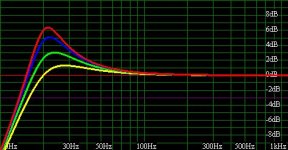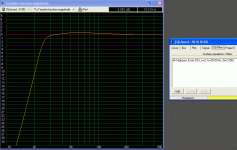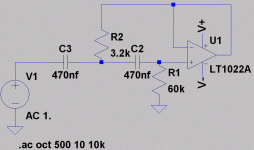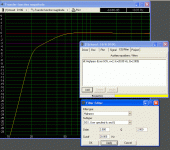I had previously been looking at TL designs but have recently became more interested in sealed designs (partly for smaller dimensions and also for the possibly tighter bass). I have been scouring for drivers since modelling my planned SPH-275C in TL designs with very little success (in part due to not being very competent with the worksheets but it doesn't look like it's going to work anyhow).
For sealed enclosures I have 2 drivers of interest. One is the Peerless 830669. This can produce decent extension in a sealed box but a concern is that it is listed as a subwoofer and I wonder if its higher ranges might be less than optimal (400-450hz crossover, 24db planned). Also at 12" is it likely to couple badly to 4" mids (see mid-top thread for detail http://www.diyaudio.com/forums/showthread.php?s=&threadid=107381&perpage=25&pagenumber=2)?
Another option which is looking better is the Hi-Vi D10G (attached graph). This produces slightly better extension in a smaller box and should have decent upper response, graph looks decent up to 2khz. At 10" it is more reasonably sized. Costs a lot more but thats ok
I feel though that the natural rolloff, though good for sealed, will need to be electronically compensated to give satisfying bass. Flat to 30hz would be reasonable, with 6db loss I will require 4 times the power at this frequency, but I can up the output of my bass amp quite easily to give 200W per channel (if required, its currently 80)
What kind of active circuit would be used though in a woofer (not subwoofer) application? Not ELF nor LT seem appropriate, I need something which produces boost (complementary to the natural rolloff) below say 60Hz but does not affect the signal above this frequency. Naturally boost needs to be limited below 30hz too and phase shifts in the upper response need to be minimised. Is the filter called a shelving filter? Any help on this aspect would be great and input on the likely success of these woofers in this application
For sealed enclosures I have 2 drivers of interest. One is the Peerless 830669. This can produce decent extension in a sealed box but a concern is that it is listed as a subwoofer and I wonder if its higher ranges might be less than optimal (400-450hz crossover, 24db planned). Also at 12" is it likely to couple badly to 4" mids (see mid-top thread for detail http://www.diyaudio.com/forums/showthread.php?s=&threadid=107381&perpage=25&pagenumber=2)?
Another option which is looking better is the Hi-Vi D10G (attached graph). This produces slightly better extension in a smaller box and should have decent upper response, graph looks decent up to 2khz. At 10" it is more reasonably sized. Costs a lot more but thats ok
I feel though that the natural rolloff, though good for sealed, will need to be electronically compensated to give satisfying bass. Flat to 30hz would be reasonable, with 6db loss I will require 4 times the power at this frequency, but I can up the output of my bass amp quite easily to give 200W per channel (if required, its currently 80)
What kind of active circuit would be used though in a woofer (not subwoofer) application? Not ELF nor LT seem appropriate, I need something which produces boost (complementary to the natural rolloff) below say 60Hz but does not affect the signal above this frequency. Naturally boost needs to be limited below 30hz too and phase shifts in the upper response need to be minimised. Is the filter called a shelving filter? Any help on this aspect would be great and input on the likely success of these woofers in this application
Attachments
I’ve got some experience with the SPH-225C (smaller brother to the SPH-275C) and have tried a few permutations with them. In a very small sealed box (12L) they produce very clean, tight and to me accurate bass but the low end is badly missing. I thought this would be a great solution using it as a mid-bass but I tried for hours to get a 12” ATC to integrate and got no where, maybe lack of experience but I gave up on that idea.
I am currently using two SPH-225C in a 35L cab tuned to 30hz, this is (to me) is producing a good compromise between extension and clarity but still it does not really dig deep. Did try 44L tuned to 35hz and the bass extension was much improved but I felt the detail in the upper bass was being compromised. Currently crossing them over at 300hz to the mid and with my combination of drivers this sounds like the sweet spot. Have tried upto 800hz but I felt it was starting to sound thin.
I am currently using two SPH-225C in a 35L cab tuned to 30hz, this is (to me) is producing a good compromise between extension and clarity but still it does not really dig deep. Did try 44L tuned to 35hz and the bass extension was much improved but I felt the detail in the upper bass was being compromised. Currently crossing them over at 300hz to the mid and with my combination of drivers this sounds like the sweet spot. Have tried upto 800hz but I felt it was starting to sound thin.
Dr.EM said:
What kind of active circuit would be used though in a woofer (not subwoofer) application? Not ELF nor LT seem appropriate, I need something which produces boost (complementary to the natural rolloff) below say 60Hz but does not affect the signal above this frequency. Naturally boost needs to be limited below 30hz too and phase shifts in the upper response need to be minimised. Is the filter called a shelving filter? Any help on this aspect would be great and input on the likely success of these woofers in this application
Hi,
Sounds like a standard 2nd order high pass filter with variable Q.
Attachments
That graph looks great, can you post the schematic you used to create it? Having difficulty finding one; found that shelving filter but yours looks better as it combines the highpass function.
My original plans were with the SPH-275C in a TL as it seemed to have good specs for it. Since that didn't model out very well and sealed or BR boxes also model to have high rolloff I kind of abondoned it (though it still looks like a very nice driver). Having built a small sub I know that I want those deep notes, so something which reaches low is a requirement I feel. The upper response of the Hi-Vi driver doesn't look as clean but hopefully will take a 400hz crossover no problem.
My original plans were with the SPH-275C in a TL as it seemed to have good specs for it. Since that didn't model out very well and sealed or BR boxes also model to have high rolloff I kind of abondoned it (though it still looks like a very nice driver). Having built a small sub I know that I want those deep notes, so something which reaches low is a requirement I feel. The upper response of the Hi-Vi driver doesn't look as clean but hopefully will take a 400hz crossover no problem.
http://linkwitzlab.com/filters.htm#9
have a read
Half an octave extension works.
One octave uses up a lot of power and a lot of driver cone travel even for modest SPL.
One and a half octaves of extension become virtually unmanageable.
have a read
Half an octave extension works.
One octave uses up a lot of power and a lot of driver cone travel even for modest SPL.
One and a half octaves of extension become virtually unmanageable.
Is that the same circuit as what sreten posted? I modelled it on switchercad before posting this thread (along with the ESP ELF one) but it has that little dip in the response to account for boost in the driver output caused by a small box with high Qtc. My box will have optimum Qtc so the response graph sreten posted looks ideal for my application (boost from flat and then cut to prevent excessive excursion).
I guess I am aiming for a little under 1 octave, but the max boost will be 6db in any case (keeping it flat to 30hz). Response below this should still remain but will be attenuated (hopefully not as much as a BR though).
Also, Win ISD won't model excursion, but I have MJK matchcad worksheets which can. Problem is, I can't actually figure out how to enter my box volume on the closed box sheet! If anyone knows a way to convert the litres into the required format I'd be grateful if they could disclose it! Excursion is likely to be the biggest concern, power handling on that driver is quite good (4" voice coil).
I guess I am aiming for a little under 1 octave, but the max boost will be 6db in any case (keeping it flat to 30hz). Response below this should still remain but will be attenuated (hopefully not as much as a BR though).
Also, Win ISD won't model excursion, but I have MJK matchcad worksheets which can. Problem is, I can't actually figure out how to enter my box volume on the closed box sheet! If anyone knows a way to convert the litres into the required format I'd be grateful if they could disclose it! Excursion is likely to be the biggest concern, power handling on that driver is quite good (4" voice coil).
Dr.EM said:Is that the same circuit as what sreten posted?
Hi,
No. Its the high pass section of http://linkwitzlab.com/filters.htm#2
with F = 20Hz and Q varied, 1, 1.3, 1.7, 2. Can be implemented
around the power amplifier rather than using an op-amp.
WinISDpro Alpha models excursion and prefilters.
Many thanks for your help! I've been modelling this system and attach the results. A filter with Q2.2 at 25hz seems to give a good overall response, -3db at 24.4hz.
Output limits are around 101db for a pair at 30hz. I'm not sure if this is very much, though room gain should add a bit to bring it up. The "good news" is that my amplifier won't appear to need modifying since the max power at 30hz is limited to 47watts (to stay within linear xmax). I have 80 available, which could still probably be used with an increase in distortion. Apparently levels in music at below 40hz are usually quite a lot lower anyhow (which potentially means I can use more power in the upper bass ranges).
Output limits are around 101db for a pair at 30hz. I'm not sure if this is very much, though room gain should add a bit to bring it up. The "good news" is that my amplifier won't appear to need modifying since the max power at 30hz is limited to 47watts (to stay within linear xmax). I have 80 available, which could still probably be used with an increase in distortion. Apparently levels in music at below 40hz are usually quite a lot lower anyhow (which potentially means I can use more power in the upper bass ranges).
Attachments
Hi,
IMO equing to flat and maximising f3 will produce boom at the
"knee" point. Such an alignment does not consider room gain.
Forget flat, and eq to maximise f6 and/or f10 will produce a
smoother transition and thus have better phase and transient
response, any droop should be taken care of by room gain.
As a minimum make F adjustable, for a Q of ~ 2 I'd say a
setting around 20Hz is the sort of thing need, but JMO.
 /sreten.
/sreten.
IMO equing to flat and maximising f3 will produce boom at the
"knee" point. Such an alignment does not consider room gain.
Forget flat, and eq to maximise f6 and/or f10 will produce a
smoother transition and thus have better phase and transient
response, any droop should be taken care of by room gain.
As a minimum make F adjustable, for a Q of ~ 2 I'd say a
setting around 20Hz is the sort of thing need, but JMO.
I was EQ ing to flat by bringing up the F6 point (30hz) by about 6db (though the filter was at 25hz). I think I can see what you mean though, it does give a very rapid drop off at lower than 30hz. I attach a diagram of the filter set at 20hz, Q2; your suggesting room gain will help boost the 20-40hz area to give a flatter response in room and by doing so ultimately give more extended bass?
If I carry out this design I will make trials on breadboard to find an effective frequency. I will likely build it into the preamp/crossover box and may well add options to change this frequency or remove the filter from the circuit (accounts for different rooms and preventing annoying people etc).
My concern is still output, at 20hz the driver can only take 38Watts to stay within linear xmax. This is only 93db output for a pair at 20hz, 101db at 30hz. Room gain will help but I have a feeling this still isn't a great deal (mids and tweeters can do 112db).
If I carry out this design I will make trials on breadboard to find an effective frequency. I will likely build it into the preamp/crossover box and may well add options to change this frequency or remove the filter from the circuit (accounts for different rooms and preventing annoying people etc).
My concern is still output, at 20hz the driver can only take 38Watts to stay within linear xmax. This is only 93db output for a pair at 20hz, 101db at 30hz. Room gain will help but I have a feeling this still isn't a great deal (mids and tweeters can do 112db).
Attachments
Dr.EM said:
My concern is still output, at 20hz the driver can only take 38Watts
to stay within linear xmax. This is only 93db output for a pair at 20hz,
101db at 30hz. Room gain will help but I have a feeling this still isn't
a great deal (mids and tweeters can do 112db).
Hi,
Well in a much larger box you can go vented and tune in the
20's to get far more output, but power handling below Fvent ......
TBH 38w @ 20Hz for a 80w amplifier is more than ample for overload.
That is the other option, but accomodating that large box might be difficult and the sealed could produce a tighter bass (?). On the upside yes it does go a lot louder below 50hz and below Fvent is probably a rare occurence in music with the tuning around 20hz. I suppose a sub can always be added if absolutely required 

As a side note, to work out the max output increase for a pair I am simply adding 3db. Is that accurate? I mean, 2 will have twice the sensitivity, but they will also be being fed twice the power between them, surely the increase might be 6db?
As a side note, to work out the max output increase for a pair I am simply adding 3db. Is that accurate? I mean, 2 will have twice the sensitivity, but they will also be being fed twice the power between them, surely the increase might be 6db?
Cool, its a bit better then 
Another option is iso-barik loading in a BR design. Gives a resonably sized enclosure with good extension and output. About 102db at 20hz and 105db at 30hz each (which I guess then makes 108db and 111db for the pair max). Obviously put off a bit by the cost; £340 on drivers and £90 to uprate the amplifier
 . Otherwise a very happy solution (I think?).
. Otherwise a very happy solution (I think?).
Another option is iso-barik loading in a BR design. Gives a resonably sized enclosure with good extension and output. About 102db at 20hz and 105db at 30hz each (which I guess then makes 108db and 111db for the pair max). Obviously put off a bit by the cost; £340 on drivers and £90 to uprate the amplifier
Hi,
Getting heavier drivers built for smaller boxes is usually better
than going isobaric, and probably somewhat cheaper.
Still I'm not sure your seeing allthe big picture, bass is into full space,
midrange and treble half space (as are all given driver senstivities).
For a 3-way baffle step means the midrange and treble levels
are around 4 to 6 dB lower than the bass unit senstivity.
 /sreten.
/sreten.
Getting heavier drivers built for smaller boxes is usually better
than going isobaric, and probably somewhat cheaper.
Still I'm not sure your seeing allthe big picture, bass is into full space,
midrange and treble half space (as are all given driver senstivities).
For a 3-way baffle step means the midrange and treble levels
are around 4 to 6 dB lower than the bass unit senstivity.
- Status
- This old topic is closed. If you want to reopen this topic, contact a moderator using the "Report Post" button.
- Home
- Loudspeakers
- Multi-Way
- Bass for 3 way system




